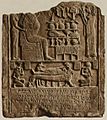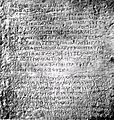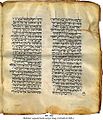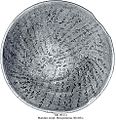Aramaic language facts for kids
Quick facts for kids Aramaic |
|
|---|---|
| ܐܪܡܝܐ, ארמיא Arāmāyā |
|
| Geographic distribution: |
Levant, Fertile Crescent, Eastern Arabia |
| Linguistic classification: | Afro-Asiatic |
| Subdivisions: |
Eastern Aramaic
Western Aramaic
|
| ISO 639-2 and 639-5: | arc |
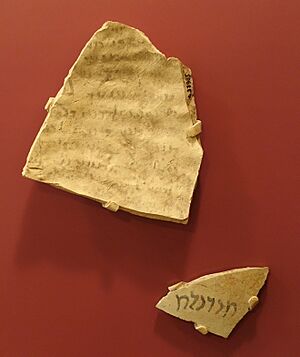
Aramaic is an ancient language from a group called Semitic languages. People have been writing Aramaic for over 3,100 years. It was spoken even longer ago!
It's part of the Northwest Semitic language family. Other languages in this family include Hebrew and Arabic.
You can find Aramaic in parts of the Bible, like the books of Daniel and Ezra. It's also used in the Jewish Talmud, an important religious text.
Aramaic uses its own alphabet with 22 letters. This alphabet was so popular that it helped create the alphabets for Hebrew, Syriac, and Arabic!
History of Aramaic
Around the 12th century BC, people who spoke Aramaic first lived in areas that are now Syria, Iraq, and eastern Turkey.
It became super important in the Middle East because it was the official language of the huge Achaemenid Empire. Jewish speakers took the language with them to North Africa and Europe.
Christian speakers also carried Aramaic to Iran, India, and even China.
In the 7th century AD, Aramaic stopped being the main language in the Middle East. The Arabic language took its place.
Today, Aramaic is still spoken by small groups of Jews, Mandaeans, and some Christians. These groups live in different parts of the Middle East.
Wars in the last two centuries have caused many Aramaic speakers to move to other countries. Now, between 500,000 and 850,000 people speak Aramaic languages around the world.
Different Kinds of Aramaic
Aramaic is not just one single language. Many different people spoke and wrote it over many centuries. This means there are many different types of Aramaic, called dialects.
Some of these dialects are so different that they are almost like separate languages!
The dialects are usually split into two main groups: an Eastern group and a Western group. The Euphrates River often marks the line between them.
The dialects are also grouped by time.
- Old Aramaic is the name for the oldest dialects. Only scholars study these today.
- Middle Aramaic dialects are used for special things, like writing and religion. They are not used for everyday talking.
- Modern Aramaic dialects are the ones spoken every day by some groups of people.
Images for kids
-
An 11th-century book written in Syriac Serto.
-
A coin of Alexander the Great with an Aramaic inscription.
-
The Kandahar Bilingual Rock Inscription (Greek and Aramaic) by Ashoka, 3rd century BC.
-
An 11th-century Hebrew Bible with Targum (Aramaic translation) between verses.
-
A 9th-century Syriac Estrangela manuscript.
See also
 In Spanish: Lenguas arameas para niños
In Spanish: Lenguas arameas para niños





